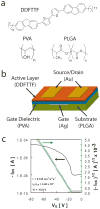Biomaterials-based electronics: polymers and interfaces for biology and medicine
- PMID: 23184740
- PMCID: PMC3642371
- DOI: 10.1002/adhm.201200071
Biomaterials-based electronics: polymers and interfaces for biology and medicine
Abstract
Advanced polymeric biomaterials continue to serve as a cornerstone for new medical technologies and therapies. The vast majority of these materials, both natural and synthetic, interact with biological matter in the absence of direct electronic communication. However, biological systems have evolved to synthesize and utilize naturally-derived materials for the generation and modulation of electrical potentials, voltage gradients, and ion flows. Bioelectric phenomena can be translated into potent signaling cues for intra- and inter-cellular communication. These cues can serve as a gateway to link synthetic devices with biological systems. This progress report will provide an update on advances in the application of electronically active biomaterials for use in organic electronics and bio-interfaces. Specific focus will be granted to covering technologies where natural and synthetic biological materials serve as integral components such as thin film electronics, in vitro cell culture models, and implantable medical devices. Future perspectives and emerging challenges will also be highlighted.
Copyright © 2012 WILEY-VCH Verlag GmbH & Co. KGaA, Weinheim.
Figures







References
-
- Levin M. Bio Essays. 2012;34:205.
-
- Zhao M, Song B, Pu J, Wada T, Reid B, Tai G, Wang F, Guo A, Walczysko P, Gu Y, Sasaki T, Suzuki A, Forrester JV, Bourne HR, Devreotes PN, McCaig CD, Penninger JM. Nature. 2006;442:457. - PubMed
-
- Irimia-Vladu M, Troshin PA, Reisinger M, Shmygleva L, Kanbur Y, Schwabegger G, Bodea M, Schwödiauer R, Mumyatov A, Fergus JW, Razumov VF, Sitter H, Sariciftci NS, Bauer S. Advanced Functional Materials. 2010;20:4017.
-
- Ito S. Pigment Cell Research. 2003;16:230. - PubMed
Publication types
MeSH terms
Substances
Grants and funding
LinkOut - more resources
Full Text Sources
Other Literature Sources

